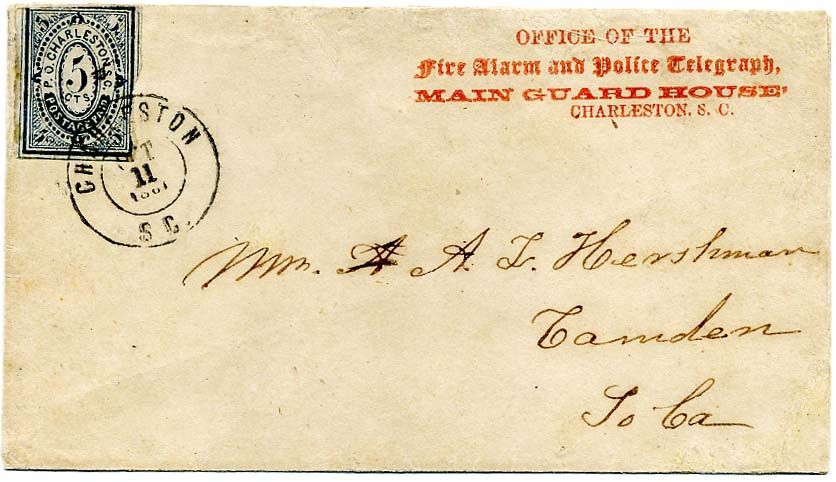-
Confederate Postal History
- CSA 1 on Cover, Section 1
- CSA 1 on Cover, Section 2
- CSA 2 on Cover
- CSA 3 on Cover
- CSA 4 on Cover
- CSA 5 on Cover
- CSA 6 on Cover
- CSA 7 on Cover Section 1
- CSA 7 on Cover Section 2
- CSA 8 on Cover
- CSA 9 on Cover
- CSA 10 on Cover
- CSA 11 on Cover Section 1
- CSA 11 on Cover Section 2
- CSA 11 on Cover Section 3
- CSA 12 on Cover Section 1
- CSA 12 on Cover Section 2
- CSA 12 on Cover Section 3
- CSA 13 on Cover
- Advertising and College Covers
- Blockade-Run Mail
- Confederate Patriotic Covers Section 1
- Confederate Patriotic Covers Section 2
- Independent State & US Used in Confederacy Section 1
- Independent State & US Used in Confederacy Section 2
- Miscellaneous Section 1
- Miscellaneous Section 2
- Mourning Covers
- Official Semi-Official and State Imprints Section 1
- Official Semi-Official and State Imprints Section 2
- Postmasters' Provisionals on Cover Section 1
- Postmasters' Provisionals on Cover Section 2
- Postmasters' Provisionals on Cover Section 3
- Prisoner of War & Cilvilian Flag of Truce Section 1
- Prisoner of War & Cilvilian Flag of Truce Section 2
- Prisoner of War & Cilvilian Flag of Truce Section 3
- Railroad Covers
- Sternes Correspondence
- Wallpaper Covers
- Confederate Stampless
-
Confederate Stamps
- Essays, Proofs, Private Printings
- Postmasters' Provisionals Section 1
- Postmasters' Provisionals Section 2
- Confederate Use of US Postage
- CSA 1 5 Cents Lithograph
- CSA 2 10 Cents Lithograph
- CSA 3 2 cents Lithograph
- CSA 4 5 cents Lithograph
- CSA 5 10 Cents Lithograph
- CSA 6 5 Cents Typograph
- CSA 7 5 Cents Typograph
- CSA 8 2 Cents Engraved
- CSA 9 10 Cents Engraved
- CSA 10 10 Cents Engraved
- CSA 11 10 Cents Engraved, Section 1
- CSA 11 10 Cents Engraved, Section 2
- CSA 12 10 Cents Engraved, Section 1
- CSA 12 10 Cents Engraved, Section 2
- CSA 13 20 Cents Engraved
- CSA 14 1 Cent Typograph
- Philatelic Literature
Navigate from drop-down boxes above or TABLE OF CONTENTS
In lot descriptions:
SCV = Scott Catalogue Value
CCV = 2012 CSA Catalog Value
Unused = no gum unless noted
Content anywhere underlined in blue is a clickable link - follow it
CSA Catalog vs. Scott Color Designation Chart
Click on thumbnails to enlarge
and see full item information
Please use Secure Interactive Order Form and carefully read the
Ordering and Sales Policies page before ordering.

Item# 13931
Price: $6,000
Charleston S.C., 5¢ Blue #16X1 with large margins showing outer framelines to just in at top and lower right, tied by neat Charleston S.C. Oct. 11, 1861 dc on cover to Mrs. A. L. Hershman in Camden So Ca with "Office of the Fire Alarm and Police Telegraph, Main Guard House, Charleston S.C." red imprint; expertly repaired mostly along edges, Very Fine appearance. THE FINER OF THE TWO RECORDED "FIRE ALARM AND POLICE TELEGRAPH" IMPRINT COVERS WITH THE CHARLESTON POSTMASTER'S PROVISIONAL. $6,000.
The Fire Alarm and Police Telegraph system was installed in Charleston by John Nelson Gamewell, a Camden S.C. postmaster and telegraph operator who purchased rights to the system in 1855 (the Gamewell Fire Alarm Company still exists). The first city to use a telegraph system to transmit fire and police alarms was Boston in 1852, followed by Philadelphia in 1855, and St. Louis, Baltimore and New Orleans between 1858 and 1860. The city of Charleston started discussions about using Gamewell’s system as early as 1855, but apparently decided against it. In August 1860 the Charleston Courier reported that Gamewell was visiting the city again to demonstrate his product. On September 4 the city council reviewed a detailed proposal from Gamewell, specifying the locations of the telegraph alarms (Charleston Courier, September 6, 1860), and shortly thereafter the city entered into a contract with him. The April 3, 1861, Charleston Courier reported that the system was operational.
Exactly two months after this cover was mailed to Camden S.C., a fire broke out at a window blind and sash factory located at East Bay and Hasell Streets. It was reported to have been caused by a group of slaves who were gathered around a campfire. The fire quickly spread southwest and destroyed about 15% of the city before it was finally extinguished. Some sources say that efforts to control the fire were impeded by the fact that so many firemen had left to fight in the Confederate army. Robert E. Lee was in Charleston that night and observed the conflagration from the balcony of the Mills House hotel before its proximity forced him to leave.
One of the two recorded Fire Alarm and Police Telegraph covers, both from the same correspondence. Ex Calhoun
